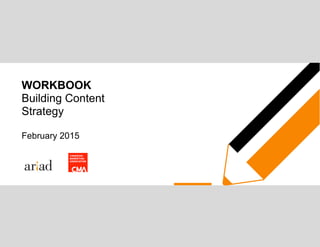
CMA 2015 Content Strategy Seminar Workbook - February 2015
- 2. 1 Exercise 1: Tell your own story. Use the space below to tell the story of your company or organization. Tell us why you are great – even the best. Draw on your history, the present, and the vision for the future. Why do your customers and clients love to work with you? Be creative. Be boastful. Sell us on your organization.
- 3. 2 Exercise 2: Establish your own business objectives. Here’s how: 1. Write down the greatest challenge(s) your organization faces (this is the thing that keeps you up at night). 2. Next, write down how you might address this challenge (this is your business objective). 3. Finally use the MFB criteria to determine if your proposed solution is a good objective. M=Measurable F=Focused B=Business Impact Challenges How to address challenge M F B
- 4. 3 Exercise 3: List your potential audiences. List your audiences in order of priority. Be as specific as possible about each, for example: “citizens of Markham who use recreational services” is better than “the general public”. 1. 2. 3. 4. 5.
- 5. 4 Exercise 4: Create a profile of one audience member. Fill in the profile below to the best of your ability. While you complete the profile, try to imagine what life is like through your customer’s perspective. Name Family Gender Occupation Age Media Habits Likes: Dislikes: How they interact with our organization? How do they feel about their interactions with our organization?
- 6. 5 Exercise 5: Map your customer’s journey. Your customer will likely have many important interactions with your organization. In this exercise, please pick the most important interaction your customer (profiled in Exercise 4) has with your organization. Briefly describe the interaction in the space provided. Then, imagine and document in as much detail as possible what your customer will be thinking, feeling, wanting, and doing both before the interaction and after the interaction. BEFORE KEY INTERACTION AFTER
- 7. 6 Exercise 6: Identify content opportunities along the journey. Now that you have considered your customer’s journey (Exercise 5), start to think about what type of content your customer will need at each step of his or her journey. First, write down the specific steps of your customer’s journey in the circles below, both before and after your customer’s key interaction. Next, brainstorm the type of content that would address your customer’s needs at each step. This will determine what content opportunities exist to connect with your customer (in boxes below). Before Key Interaction After
- 8. 7 Exercise 7: Create a content strategy statement. Look back on all of the work you’ve completed so far. Distill this thinking down into a single statement of no more than three sentences about the strategy you propose. The statement should address the needs of your audience as well as the needs of your organization. Then annotate the statement. The annotations are the rationale for the strategy. A good way to start thinking it through is by challenging yourself to complete the sentence: “We will help our customer by ___________________________.”
- 9. 8 Exercise 8:Define the essence and substance of your brand’s conversation with customers. To ensure your content is aligned with your organization’s brand, and is distinct from your competitors’ content, first think about how your brand provides value to your customer. Next, describe how you unlock your brand’s offering to your customers. Essence: How do we provide real value to our customers’ lives? Substance: How do we demonstrate how to engage with our brand or organization?
- 10. 9 Exercise 9: Explore content themes or territories. To determine potential topics that you will cover through content, place one content territory (i.e., the type of content your customer would find useful, Exercise 6, and that would advance at least one business objective, Exercise 2) at the centre of the “spider graph” below. Next, ideate and expand all the possible ways this content territory could be brought to life.
- 11. 10 Exercise 10: Map story ideas to different channels. Now that you have explored different content themes or territories in Exercise 9, use the template below to determine how a content territory could be leveraged in each different media channel. You will need to consider how to alter and extend the idea so that it is applicable for a number of different channels. Finally, these ideas should then be evaluated against the profile from Exercise 4 to ensure they are likely to be valued by the target audience. CONTENT TERRITORY: PROFILE NAME: CHANNEL IDEA DESCRIPTION Web Email Social Media Partnerships In-Store Out of Home Media Advertising Events
- 12. 11 Exercise 11: Plan out your content calendar. Now that you have a large amount of content to create, it is essential to make a content plan to ensure that your ideas fit with existing marketing and communications plans. A content calendar will also ensure that you spread out your content ideas and will enable you to verify that you have an achievable plan. Jan Feb March April May June July Aug Sept Oct Nov Dec Key Existing Marketing Activities Content Idea 1 Content Idea 2
- 13. 12 OOO For more information & resources CMA http://www.the-cma.org/ Additional Courses / Events http://www.the-cma.org/education-events CMA Resource Library http://www.the-cma.org/resource Ariad – blogs, case studies, and more http://ariad.ca/ To obtain additional copies of this workbook or presentation: dkille@ariad.ca White Papers OOO
